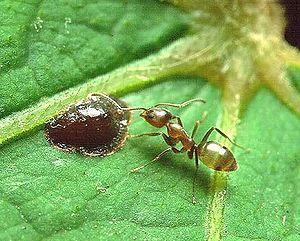The invasive usurpers from South America have proved difficult to fight with insecticides and other traditional measures. Scientists hope the new genetic information will help.
In 1907 Argentine ants (Linepithema humile) arrived in Los Angeles via a cargo ship. Within just a few years of their arrival the six-legged stowaways formed a single, massive colony—known as a supercolony—that stretched through California from south of the Mexico border to San Francisco
A liberal spraying of pesticides in the past century has done nothing to diminish the ants’ numbers—L. humile infestations are the most common cause of pest control calls in southern California. The Argentine ant’s takeover of coastal California is marked by small shifts in the local, native ecosystem. Populations of the coast horned lizard (Phrynosoma coronatum) have declined sharply in recent years due to the displacement of native ants the lizard depends on for food. Citrus farmers have required increasing quantities of pesticides to cope with rising numbers of aphids, scale insects and other pests that the Argentines actively protect in exchange for the sweet honeydew they produce.
In an effort to better understand and help combat the ants, a group of researchers led by Neil Tsutsui at the University of California, Berkeley, sequenced the genome of L. humile. The results were published January 31 in Proceedings of the National Academy of Sciences.
“An increasingly large number of research groups are focusing on Argentine ants because of their agricultural problems,” Tsutsui says. “One of our main goals was just to provide a large resource for the community of scientists that study Argentine ant biology.”
Tsutsui and colleagues found an unusually large number of chemical receptor genes that allow the ants to recognize and process different environmental chemical cues. The Argentines have 367 of these genes, compared with 174 in honeybees and 79 in mosquitoes. All ants communicate largely by “smelling” different chemicals in the environment with their antennae. Tsutsui said that identifying both the chemicals and the messages they send, researchers might be able to disrupt the Argentines’ normal behavior.
“We know a lot about the behavioral processes that are regulated by these chemicals, and we know a lot about the chemicals themselves, but we don’t know much about the missing links in between those two things,” Tsutsui says.









